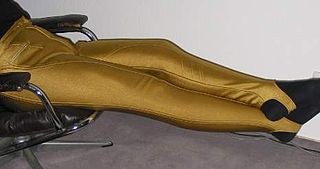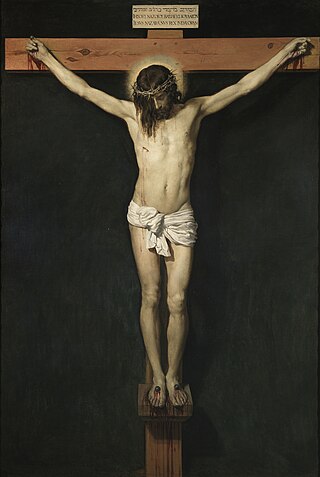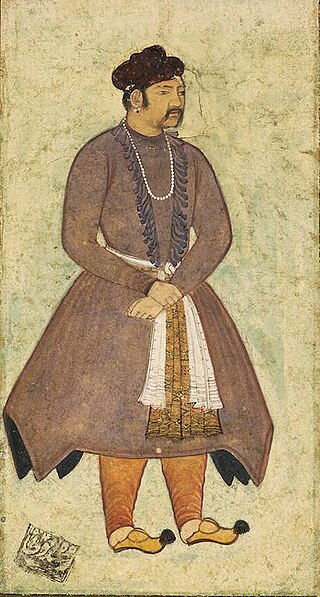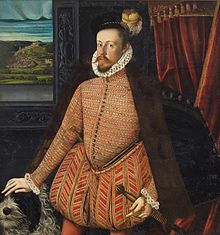
A crinoline is a stiff or structured petticoat designed to hold out a skirt, popular at various times since the mid-19th century. Originally, crinoline described a stiff fabric made of horsehair ("crin") and cotton or linen which was used to make underskirts and as a dress lining. The term crin or crinoline continues to be applied to a nylon stiffening tape used for interfacing and lining hemlines in the 21st century.

The hanbok is a traditional clothing of the Korean people. The term hanbok is primarily used by South Koreans; North Koreans refer to the clothes as chosŏn-ot (조선옷).

The dupattā, also called chunni, chunari and chundari, is a long shawl-like scarf traditionally worn by women in the Indian subcontinent to cover the head and shoulders. The dupatta is currently used most commonly as part of the women's shalwar kameez outfit, and worn over the kurta and the gharara.

A gown, from the Saxon word, gunna, is a usually loose outer garment from knee-to-full-length worn by men and women in Europe from the Early Middle Ages to the 17th century, and continuing today in certain professions; later, the term gown was applied to any full-length woman's garment consisting of a bodice and an attached skirt. A long, loosely fitted gown called a Banyan was worn by men in the 18th century as an informal coat.

A justacorps or justaucorps is a knee-length coat worn by men in the latter half of the 17th century and throughout the 18th century. The garment is of French origin, and was introduced in England as a component of a three-piece ensemble, which also included breeches and a long vest or waistcoat. This ensemble served as the prototype of the frock coat, which in turn evolved into the modern-day three-piece suit.

A dress is a garment traditionally worn by women or girls consisting of a skirt with an attached bodice. It consists of a top piece that covers the torso and hangs down over the legs. A dress can be any one-piece garment containing a skirt of any length, and can be formal or casual.

In fashion, a sheath dress is a fitted, straight cut dress, often nipped at the waistline with no waist seam. When constructing the dress, the bodice and skirt are joined together by combining the skirt darts into one dart: this aligns the skirt darts with the bodice waist dart. The dress emphasizes the waist as its skirt portion is fitted. While the sheath dress can come in many patterns and lengths, it often is worn with short sleeves and reaches knee length.

The koukoulion is a traditional headdress worn by monks and certain patriarchs in Eastern Christianity.

Sara M. Harvey is an American costume designer, and an author of fiction and nonfiction, most notably having written multiple articles for the Greenwood Encyclopedia of Clothing Through World History. She is a regular speaker on the subjects of costume design at science-fiction conventions, and has won awards for her plus-sized creations.

Clothing in ancient Greece refers to clothing starting from the Aegean bronze age to the Hellenistic period. Clothing in ancient Greece included a wide variety of styles but primarily consisted of the chiton, peplos, himation, and chlamys. Ancient Greek civilians typically wore two pieces of clothing draped about the body: an undergarment and a cloak. The people of ancient Greece had many factors that determined what they wore and when they wore it.

Chima is a generic term for the skirt worn together with jeogori, or a short jacket in hanbok, Korean traditional clothing. It is also referred to as sang or gun in hanja in the Korean language.

An attifet is a heart-shaped headdress with a point that dips over the forehead, worn by European women in the 16th and 17th centuries. It was first worn by Catherine de Medici and Mary Queen of Scots.

Stirrup pants or stirrup leggings are a type of close-fitting women's pants that taper at the ankle, similar to leggings, except that the material extends to a band, or strap, that is worn under the arch of the foot to hold the pant leg in place. The band of material is often elasticized to prevent the material around the foot from tearing. Stirrup pants were originally sportswear for women, and remain sportswear for horse riding and skiing. However, they have come in and out of fashion during the 20th and early 21st centuries, peaking in popularity as street fashion during the 1980s to the mid 1990s.

A house dress is a type of simple dress worn informally at home for household chores or for quick errands. The term originated in the late nineteenth century to describe at-home garments designed for maximum practicality and usually made from washable fabrics. It is directly descended from the Mother Hubbard dress. House dresses are also known as dusters in American and Philippine English, a term which also encompasses the muumuu. Such dresses were a necessary part of the housewife's wardrobe in the early twentieth century and could be widely purchased through mail-order catalogues. The house dress remains a contemporary and frequently worn garment in some parts of the world.

A kiss curl describes a lock of hair curling onto the face and usually plastered down. Although the curl could be flattened with saliva, soap or hair lotion is more typically used.

Perizoma is a type of loincloth that originated with the Minoan civilization in Crete. Surviving depictions show it being worn by male and female acrobats.

The term jama refers to a long coat which was popular in South Asia during the early modern era.

A dudou is a traditional Chinese article of clothing that covers the front of the torso, originally worn as an undershirt with medicinal properties. With the opening of China, it is sometimes encountered in Western and modern Chinese fashion as a sleeveless shirt and backless halter-top blouse.
Columbia Hall, commonly known as Paresis Hall, was a brothel and gay bar located in the Bowery, in New York City, in the 1890s. Located on the Bowery near Cooper Union, the Hall was owned by the gangster James T. Ellison.

Katzeb was an article of dress encircling the body, at the waist with ends hanging in the front. It was a kind of sash also called Patka.






















